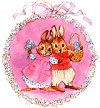

 Easter at our House
Easter at our House
| It is becoming more difficult to gather everyone for Easter but sometimes we are fortunate and most of us are together. Eggs are a part Easter - meaning new birth. Dyeing Easter eggs used to be a great part the holiday for us. It went through a lull but now with the grandchildren we are having the dyed eggs again. |
|
Our Easter Menu
Shrimp
- Smoked
Salmon Canapes
Cheese and Crackers
Roast Lamb
or Saddle of Lamb
Roast Aspargus - Mixed Spring
Vegetables
Scalloped Potatoes
Berries with Puff Paste
or
Lemon Tart with Mixed Berries
Easter Music
Easter is a celebration of three traditions.
Pagan. The word is derived From the Norse meaning the Festival of spring. March 21, when nature is the in resurrection after the winter. The rabbits and the eggs powered like rays of the returning sun and the northern lights.
Hebrew. In Exodus 12, we read of the night in Egypt when the angel of death (passed over) that dwellings out the Israelites , so sparingly their first born hence the Passover. Or the Jewish Pesach, celebrated during the first month of the Hebrew year.
Christian -- it was at the feast of Passover in Jerusalem that Jesus, a Jew was crucified and rose from the dead. Therefore Easter has a various spellings and churches throughout the East and West celebrates Easter as a major feast ranking with Christmas. The fixing that date of Easter each year has involved the churches in many problems. In the Jewish religion that calendar is lunar and Passover falls on the 15th day of the month that is a full moon. The determination of this date was a secret process jealous we guarded in the Temple and later in the synagogues, and it was according to this calculation that Christ the observed the feast. Some conservatives wanted to continue the Jewish Passover as Easter but were overruled by the church as a whole. They wanted a Holy week beginning with Palm Sunday, preceding Good Friday and ending on Easter Sunday commemorating the Resurrection. There were many discussions about which calendar to use and the western churches shows of the new style calendar and the eastern Orthodox churches settled on the old style and for that reason there are two dates for Easter
Easter Bunny and Easter Eggs

The Easter Bunny was older than Christianity; it was the Moonhare sacred to the Goddess in both eastern and western nations. Recalling the myths of Hathor-Astarte who laid the Golden Egg of the sun, Germans used to say that the hare would lay eggs for good children on Easter Eve. Easter shows its pagan origin in a dating system based on the old lunar calendar. It is fixed as the first Sunday after the first full moon after the spring equinox, formerly the "pregnant" phase of Eostre passing into the fertile season.
The Christian festival wasn't called Easter until the Goddess's name was given to it in the late Middle Ages.
The Irish kept Easter on a different
date from that of the Roman church, probably the original date of the festival of Eostre,
until the Roman calendar was imposed on them in 632AD. Nevertheless, the The
Persians began their solar New Year at the spring equinox, and up foundation and their
colonies in Britain kept the old date for another fifty years. to the middle of the 18th
century they still followed the old custom of presenting each other with colored eggs on
the occasion.

Eggs were always symbols of rebirth, which is why Easter eggs were usually colored red -- the color of life -- especially in eastern Europe.
Russians used to lay red Easter eggs on graves to serve as resurrection charms.
In Bohemia, Christ was duly honored Easter Sunday and his pagan rival on Easter Monday, which was the Moon-day opposed to the Sun-day. Village girls like ancient priestesses sacrificed the Lord of Death and threw him into water, singing, "Death swims in the water, spring comes to visit us, with eggs that are red, with yellow pancakes, we carried Death out of the village, we are carrying Summer into the village." Another remnant of the pagan sacred drama was the image of the god buried in his tomb, then withdrawn and said to live again. The church instituted such a custom early in the Middle Ages, apparently in hopes of a reportable miracle. A small sepulchral building having been erected and the consecrated host placed within, a priest was set to watch it from Good Friday to Easter Sunday. Then the host was taken out and displayed, and the congregation was told Christ was risen.
From the Woman's Book of Myths and Secrets by Barbara G. Walker:
Links
Welcome Easter Seals
Kid's Domain Easter Time
Cards, Fun, Games and Screen
savers for Easter
This Page was last updated on Tuesday, March 15, 2005 09:07:19 AM